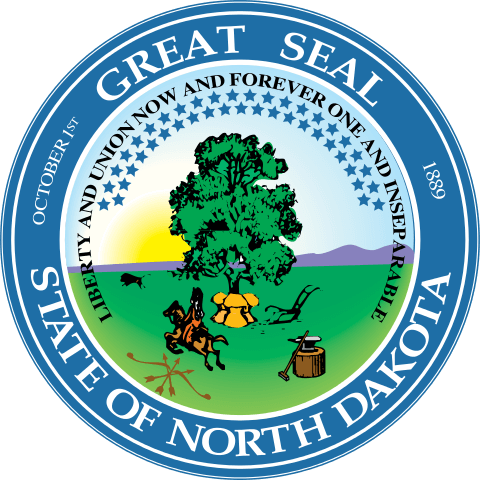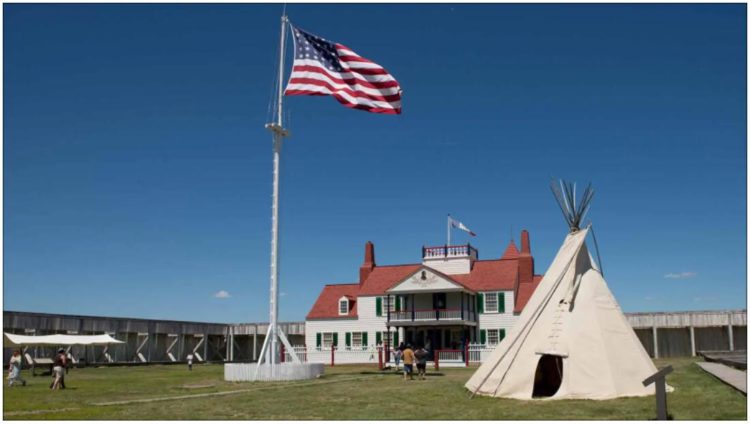North Dakota is a federal state of the United States, which is in the north of the USA, on the Canadian border. The capital is Bismarck.
North Dakota became the 39th state to join the Union after the division of Dakota Territory in 1,889. North Dakota is nicknamed Peace Garden State (Peace Garden State), named after the International Peace Garden on the border with Canada, and Sioux State. The name Dakota is derived from the Indian ethnic group of the Dakota, who lived in this area before the subjugation by the Americans and still lives here today.
| Area | 183,112 km² |
| Residents | 757,952 |
| Residents per km² | 4.1 |
| Capital | Bismarck |
| Postal Code | ND |
| ISO-3166-2 code | US-ND |
| FIPS code | 38 |
Geography
North Dakota is 183,112 km² and borders in the north on the Canadian provinces of Saskatchewan and Manitoba, in the west on Montana, in the south on South Dakota and in the east on Minnesota.
To the west are the hilly Great Plains and Badlands. In this area lie the White Butte (1069 m), the highest point in the state, and the Theodore Roosevelt National Park. The Missouri River flows through western North Dakota. There are also some natural resources in the west such as oil and lignite.
Central Dakota is home to the Drift Prairie and the Missouri Plateau. Lakes, river valleys and gently rolling hills characterize the region. The Turtle Mountains are located in the Drift Prairie near the Canadian border. The geographic center of North America is near the city of Rugby.
To the east is the flat Red River Valley that forms the curving Red River of the North. Like the other rivers in this part of the state, the Red River flows north. At the end of the last Ice Age, the river fed along with others to Lake Agassiz. Today the land around the river is very fertile, which has led to the settlement of many farms and small towns. To the east is Devil’s Lake, the largest natural lake in the state.
Climate
The North Dakota climate is a typical example of a continental climate ; the state is far from large bodies of water that could temper the climate. That is why it ranges from oppressively hot and dry summers to bitterly cold winters. Warm air masses from the Gulf of Mexico and cold air masses from the polar regions often create strong winds.
In summer, the meeting of arctic and tropical systems leads to sometimes violent thunderstorms for 20 to 40 days. Tornadoes are not uncommon and mostly occur in the southeastern quarter of the state. In winter the weather tends to be more stable: cold and dry, with occasional snowfall. Even so, the constant wind can cause snowstorms at any time in winter. Heavy snowstorms occur in late winter and early spring.
Spring floods are widespread in the very shallow Red River Valley.
History
Native Americans have settled North Dakota for at least several millennia. The first European to reach the area was the French Canadian La Vérendrye, who led an expedition to the Mandan Indian villages around 1738. The inter-tribal trade was arranged so that the tribes of North Dakotas rarely traded directly with the Europeans. Even so, the tribes maintained sufficient contact with the Europeans to be aware of the French and Spanish claims to their territory.
The Dakota Territory was sparsely populated until the late 19th century, when railways were rapidly being built and land was being sold on a large scale. A law of February 22, 1889 cleared the way to the state for North and South Dakota (and for Montana and Washington).
The dispute between the two new states as to which of them should be included first posed a problem. However, since ” North Dakota ” is in the alphabet before ” South Dakota “, North Dakota was included first in the legal gazette and thus before South Dakota 39th state.
The territorial governments as well as the first state governments were considered to be very corrupt. In the early 20th century, the strong influence of the Nonpartisan League led to social reforms. The Great Depression hit North Dakota very hard and was compounded by the farm crisis of the 1920s.
As oil prices soared and production became profitable, an oil boom began in the Williston Basin in the 1980s. As a result, the population grew to its highest level of almost 700,000 residents.
Economy
The real gross domestic product per capita (per capita real GDP) was USD 68,723 in 2016 (national average of the 50 US states: USD 57,118; national ranking: 5).
Although less than 10% of the population is employed in agriculture, it continues to play an important role. Important products are cereals, potatoes and flax. North Dakota is the largest producer of barley, sunflower seeds, wheat, and durum wheat in the United States. Cattle and turkey farming are important.
The unemployment rate was 2.6% in November 2017 (US average: 4.1%). North Dakota had the second lowest unemployment rate of any state in the country.
Raw materials
Oil and gas production has been gaining in importance since oil was discovered at Tioga in 1951, while lignite mining has declined. Technical progress and the increased oil price have led to an “oil boom” in the region, which has large deposits of tight oil (“fracking oil”). These are now increasingly exploited. In March 2012, North Dakota produced 17.9 million barrels of crude oil, so North Dakota overtook Alaska (17.5 million barrels) for the first time and was the second largest oil producer in the USA after Texas. In October 2012, 23.2 million barrels were produced, more than 11% of the total US production of 206.7 million barrels in October 2012.
North Dakota has great potential for generating wind power in the Great Plains, which has been increasingly used since 2008. Before 2008 there was hardly any significant wind power generation, but by 2010 wind power generation rose sharply to 5,236 million kWh, which corresponds to just over 4 percent of total US wind power generation.
Also known as Sioux State / Flickertail State / Peace Garden State / Rough Rider State, North Dakota is short for ND with a population of 642,200. The capital city of North Dakota is Bismarck and the biggest city is Fargo.

